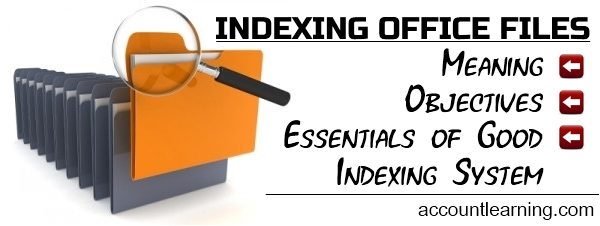Indexing of Office Files | Meaning | Objectives | Essentials
Table of Contents
What is an Index?
Index is a ready-made guide, which is used to locate the required file. Therefore, an index indicates or points out the exact place of keeping a document or file. Indexing is the process of determining the name, subject, or some other caption under which the documents are to be filed.

Index is not only necessary to large office but also necessary to small office. When a large number of files are maintained, the necessity of maintaining index is increased. Indexing increases the utility of filing by providing an easy reference to the files. The very purpose of maintaining index is that easy and quickly location of filing.
Meaning of Indexing
Indexing means an arranged system through which the required documents and papers are easily located for the speedy disposal of urgent and/or ordinary matters.
The various files are maintained for different departments on various topics. Therefore, an indicator (index) is necessary to locate the files.
Objectives of Indexing
The objects of indexing are presented below.
1. To assist filing so that the filed documents are located easily and quickly whenever they are needed.
2. To increase the efficiency of the filing method.
3. To improve the efficiency of the office operation.
4. To state the key information regarding any subject in a condensed form.
The right system of indexing must be chosen in order to achieve the objectives of indexing. Indexing is not required if files are arranged in an alphabetical order.
Essentials of a Good Indexing System
The following are the essential features of a good system of indexing.
1. Simplicity: An indexing system should be simple to understand and operate. It should not involve unnecessary complex in operation.
2. Economy: It should be economical in terms of money, space, and effort. The purchase of indexing equipment requires heavy investment during initial period. Therefore, proper attention should be devoted to ensure economical use in the end.
3. Flexibility: The selected index system should have sufficient scope for expansion. A single system may be used for several purposes. For example, the location of file, supply of important information and the like.
4. Efficiency: Any index system should ensure speed in operation and requires minimum time for operation.
5. Safety: The index system should protect the records against dust, fire, water, rats, insects, water etc. The safety should be equipped with lock facility to prevent pilferage of records.
6. Conformity with Filing System: The selection of index method depends upon the nature and type of filing system adopted in an organization. Hence, there must be a correlation between the filing system and index method.
7. Cross Reference: There should be Cross reference under the head under which a document could be filed but has not been filed.
8. Signaling: A tab or slip should be attached at the edge of the card or file. The tab or slip contains facts of the document briefly. This is used to draw the attention of the needy persons of files.

